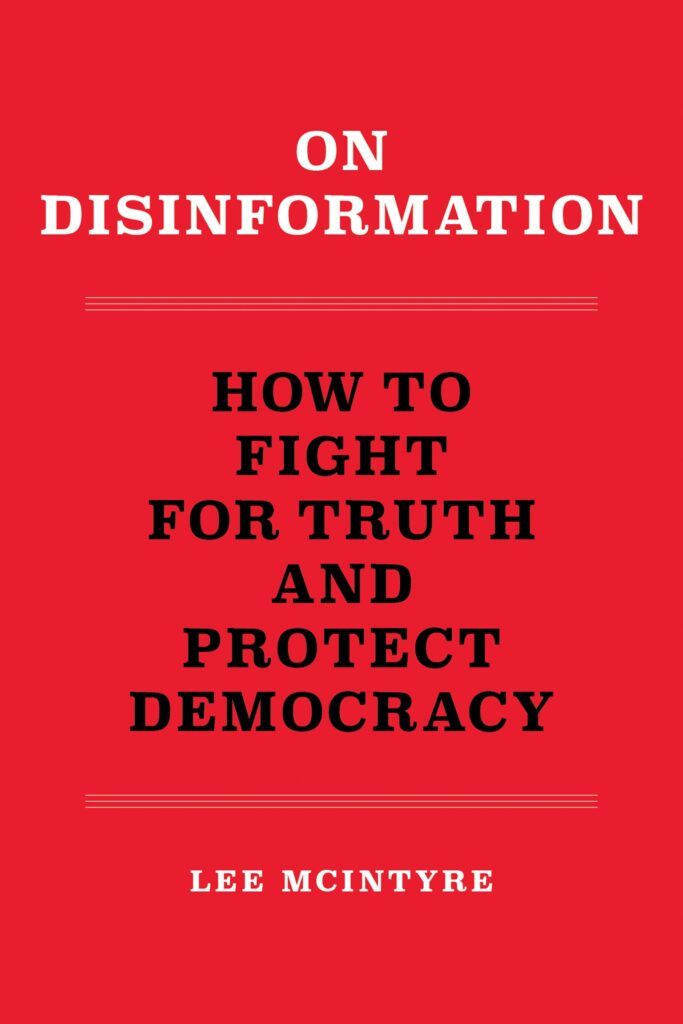In our social media age, misinformation can spread like wildfire creating an ecosystem of reality denial, where truth has become subordinate to ideology and feelings have more weight than evidence. What can we do about it?
Lee McIntyre, a research fellow at Boston University, has laid out a playbook on how to fight disinformation campaigns in his book On Disinformation: How to Fight for Truth and Protect Democracy
First, it’s worth distinguishing between misinformation and disinformation. Misinformation is false or inaccurate information that is spread, regardless of intent to mislead. We are all guilty of spreading misinformation from time to time as our memory or understanding may fail us. On the other hand disinformation is misinformation that is intentionally spread with a strategic intent to mislead. In short, misinformation is an accident or a mistake, but disinformation is a lie.
McIntyre provides a chapter on the modern history of strategic denialism, noting that disinformation in the form of propaganda has been around for centuries. He starts by citing the tobacco industry campaigns of the 1950s which sought to undermine the growing evidence of the dangers to health of smoking. This strategy has since been adopted by groups from the fossil fuel industry to the anti-vaxxers to Trump’s ‘big lie’ regarding the 2020 USA presidential election result.
In the chapter ‘The Creators’, the five common elements of any denialist campaign are set out as: (1) cherry-pick evidence, (2) believe in conspiracy theories, (3) engage in illogical reasoning, (4) rely on fake experts and denigrate real ones, and (5) have impossible expectations for what the other side must achieve. As an example of the fifth element, the author cites Trump and his followers who refuse to give up their false belief that the 2020 election was ‘stolen’, unless it is proven that it was not stolen, despite exhaustive evidence disproving the premise that it was stolen.

For strategic denialism to succeed, disinformation must be created, it must be amplified and it must be believed. Subsequent chapters cover off on each of these elements.
McIntyre touches on some of the techniques used in denialism. These include “the firehose of lies” which can make it harder to find the truth in a zone ‘flooded with shit’, “whataboutism” which paints false equivalencies, and “repetition” which normalizes the lie.
“The genius of disinformation is that it doesn’t just get you to believe a falsehood but to distrust (and sometimes even hate) anyone who does not also believe this same falsehood.”
Lee McIntyre, On Disinformation
The chapter on The Amplifiers focuses on the social media companies and the mainstream media. The author believes that tech companies don’t stop disinformation as much as they could because it would reduce ‘engagement’. Similarly, he is critical of the partisan media such as FoxNews for deliberately spreading lies (as proven by the Dominion law suit), and of the more mainstream media for their reluctance to call out lies and falling back to the defence of ‘balanced’ coverage.
In the concluding chapters, the author brings up the first direct way that the reader can fight disinformation. That is to talk with The Believers who have fallen for the disinformation. But, just as advocated by Dr Katherine Hayhoe and author Rebecca Huntley on talking about climate change, the conversation can’t just be about facts, but must be about values. A denialist’s position is most often taken because of how it makes them feel.
My own personal experience of the effectiveness of face-to-face talks is the success of Independent political candidates in the most recent Australian election. Dr Monique Ryan’s successful campaign knocked on every door in her electorate and held respectful conversations with voters. Ryan is following the same playbook in the forthcoming referendum vote to change the constitution to recognize Australia’s Indigenous peoples. The conservative party has come out against the change using many of the disinformation techniques discussed in McIntyre’s book. Sadly, they are proving effective.
The final chapter of the book expands on ten ways in which readers can combat disinformation. Some of these aren’t real actions and some are variations of each other. Nevertheless, I have selected a few that most resonated with me.
- Repeat the truth more often.
- Confront the liars, those responsible for disinformation. An example is Gerald Kutney and the #ClimateBrawl community.
- Resist polarization. The target of a disinformation campaign is not just the ‘believers’ but also the disbelievers. They are polarizing you too.
- Engage in political activism to try to regulate social media. I have previously written about author Grant Ennis’s view that advocacy for legislative change is the most effective action a citizen can take.
- Take solace in the fact that there are many others out there who are also engaged in this battle. You are not alone.
On Disinformation provides an overview of first, how we got to this place where feelings carry more weight than evidence, and secondly the essential elements of disinformation campaigns. Most importantly, it gives suggestions on how ordinary citizens can do something about it. As a pocket-sized book it’s worth reading in a single sitting and passing on to others with similar concerns over the growing war on truth.
The reviewer is a co-author of Court of the Grandchildren, a novel set in 2050s America.
Main image credit: Mohamed Hassan at Pixabay
